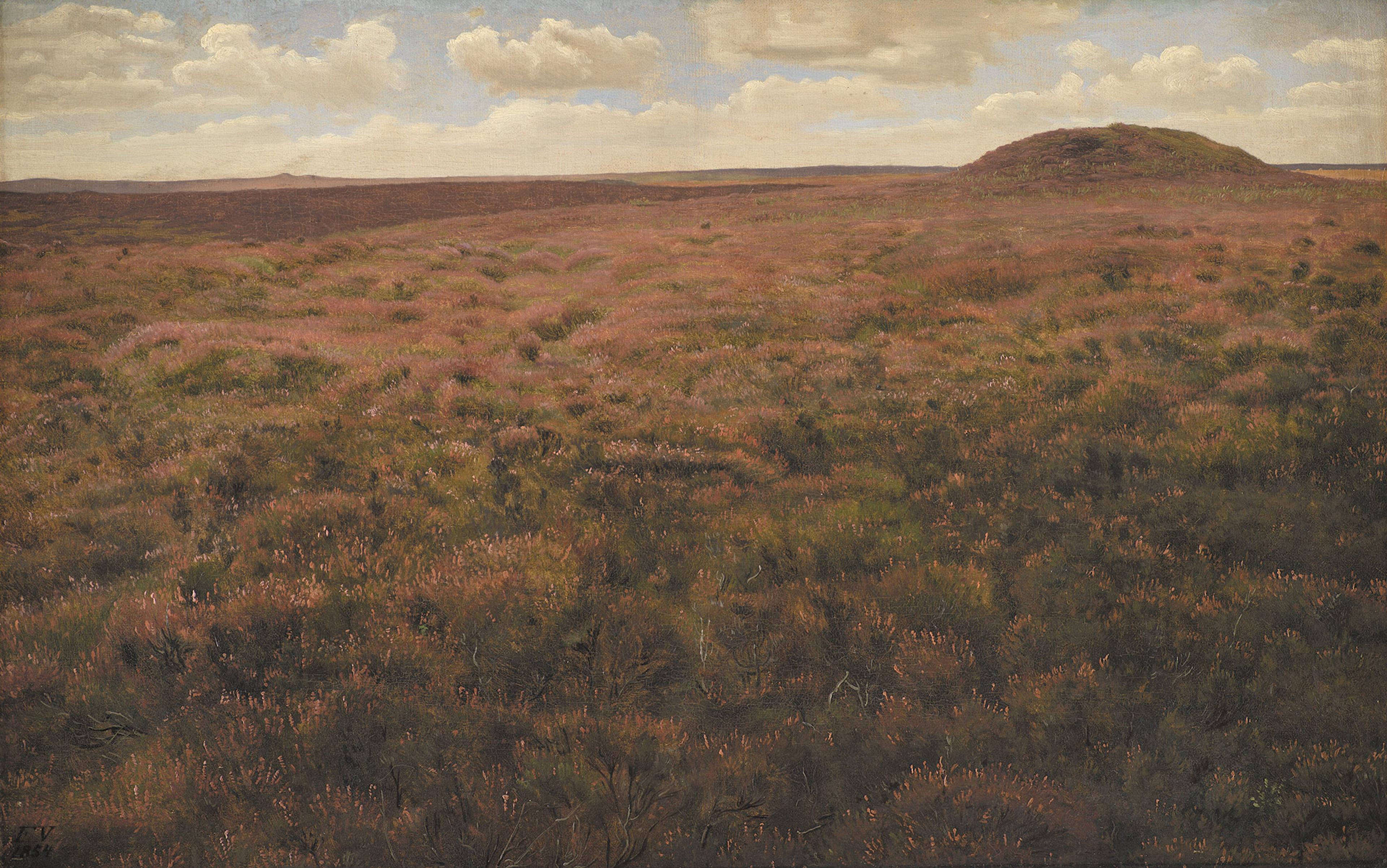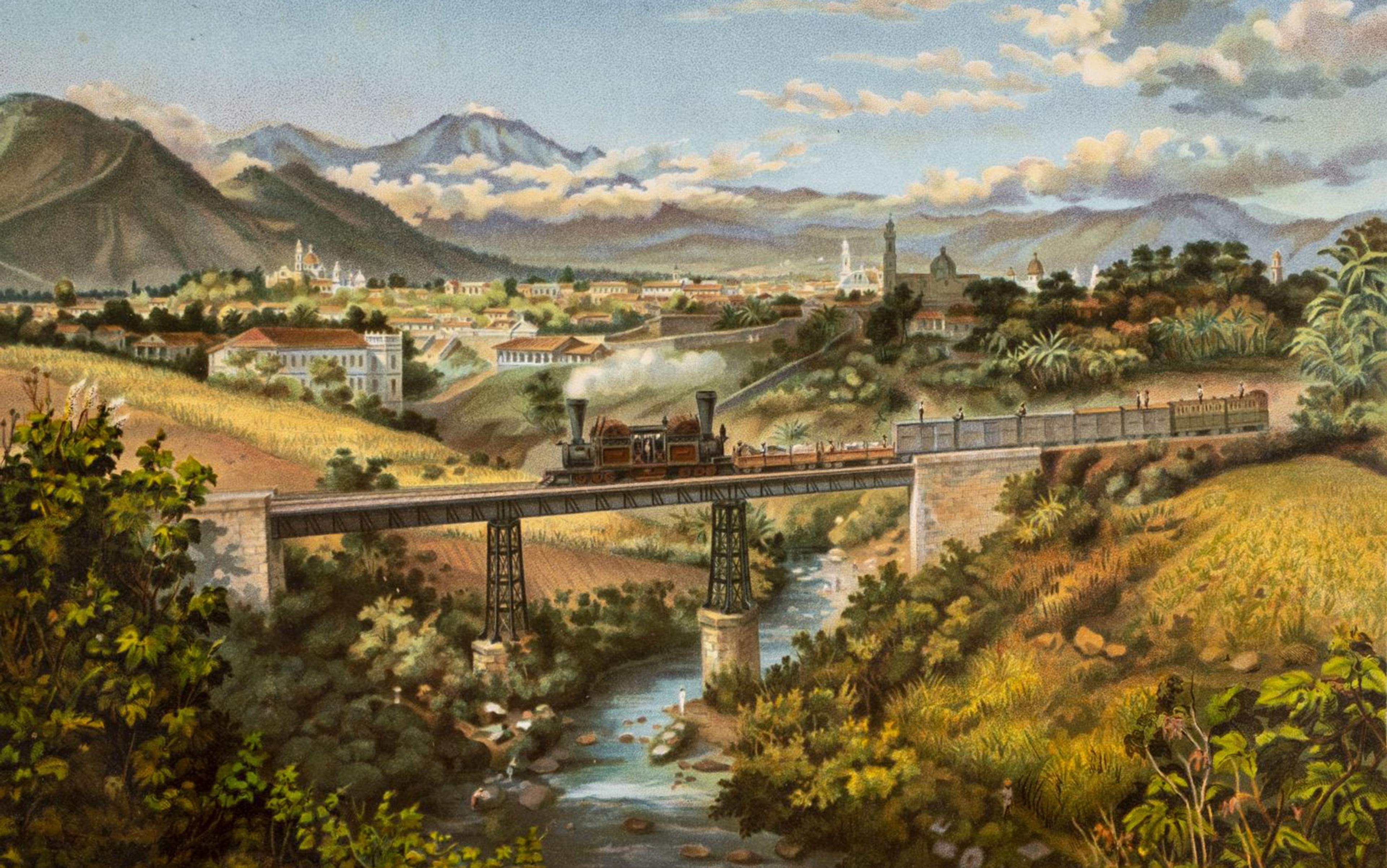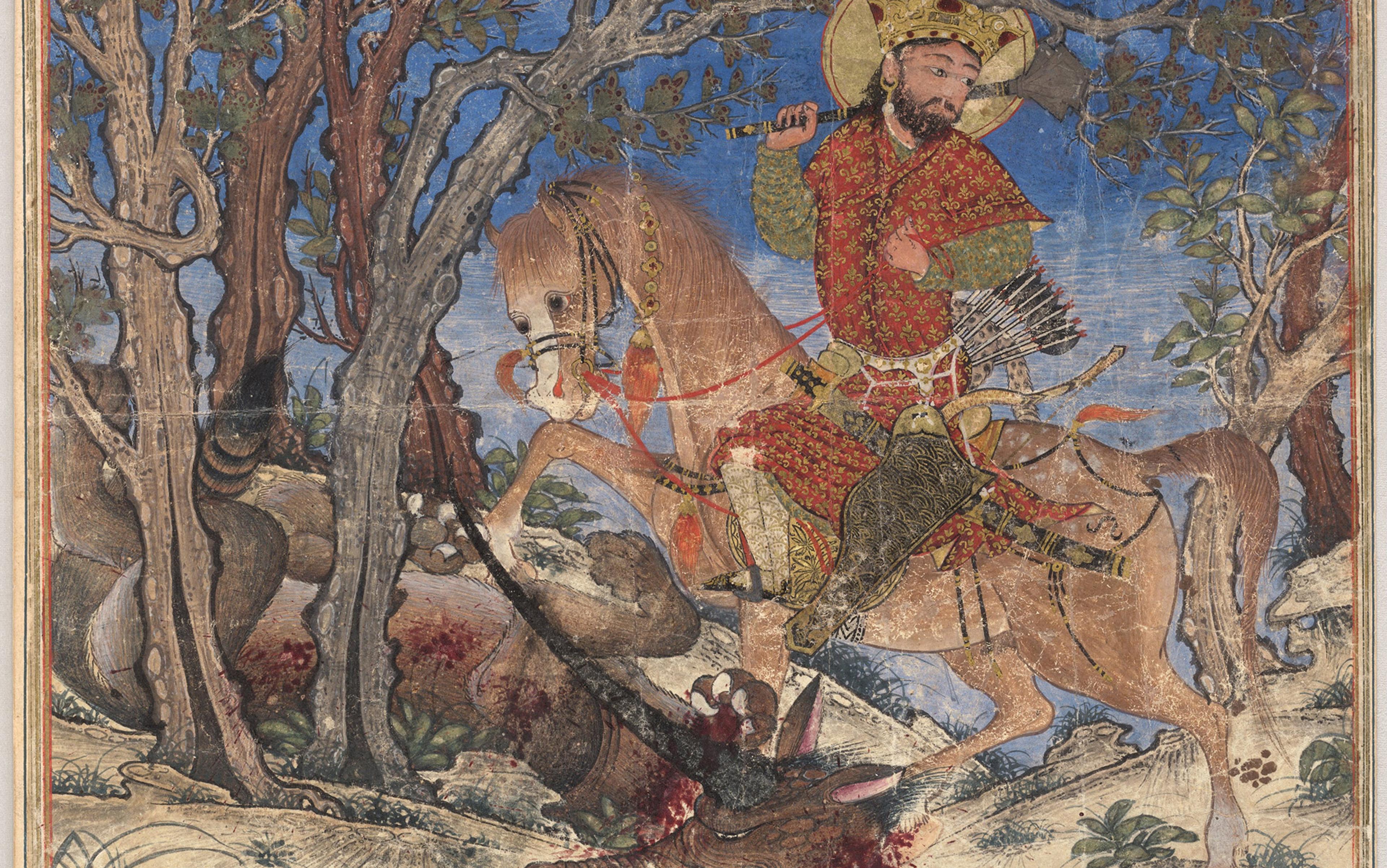Steady blows from flint axes echo through the forest. Each strike cuts deeper into the layers of a tree trunk, rhythmically interrupting the chattering of birds and the hum of swarming insects. Someone is calling, but their voice is drowned out by cracking in the underwood – another tree is falling. We are watching the making of a forest clearing, 5,000 years ago, somewhere near western Jutland in modern-day Denmark.
Beneath a dense weave of oak, hazel, elm and ash is a landscape of gentle hills. We can barely make out their contours through the trees. When we move, we follow passageways made by trunks and branches: here, impassable; there, pliable and yielding. As more trees fall, light pours onto wildlife and plants in the underwood. Down here, among sun-starved grasses and shrubs, is a little plant that will one day be called hæddre or heather. The smell of its burning leaves fills the air.
Deeper in the woods, nomadic Neolithic pastoralists are setting fires. Grey smoke hangs beneath the crowns of standing trees. The fire crackles. Oil in the heather’s shiny leaves – lustrous with fire-loving resin – bursts when ignited, and its dormant seeds begin to awaken in the flames. It is as if the plant is quietly whistling: ‘Burn me!’ Next year, once the last of the fallen trees have been hauled away and the fires in the clearing have been extinguished, new heather shoots will grow in these expanding patches of burned sun-lit pasture. What those shoots promise is a new horizon of pastoral possibility: when winter comes, and other resources dwindle, green and nutritious heather will be thriving here. This clearing will allow the survival of the herd.
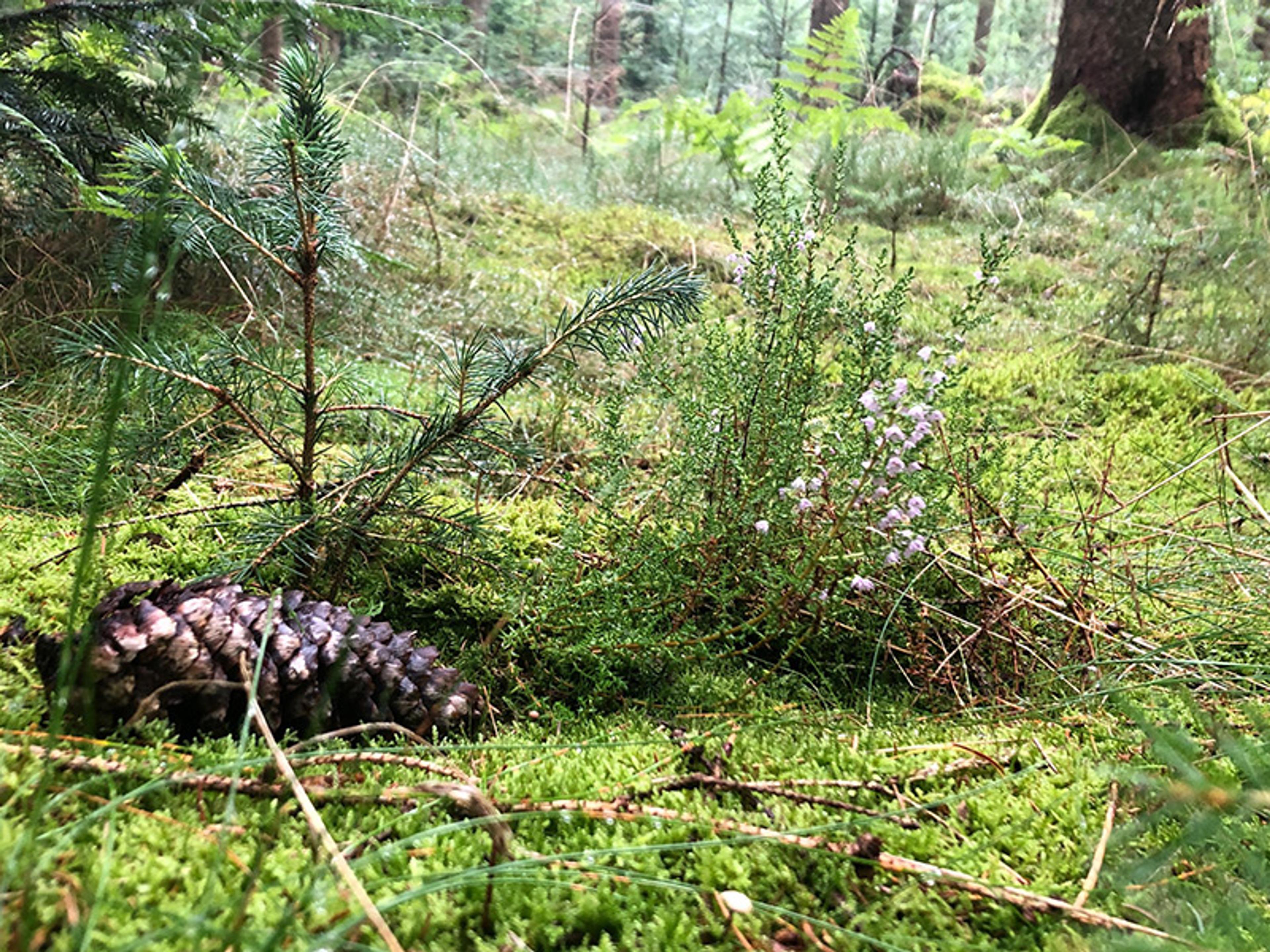
Reconstructing moments like these – via pollen records and charred plant materials in archaeological excavations – allows us to tell a unique story about human-changed landscapes. Inside the forest, we witness a small, flammable shrub becoming a key resource that will one day cover millions of hectares across northern Europe, forming a colossal belt of heathlands stretching from Portugal to Ireland, and all the way up to the Lofoten archipelago in Norway. But this is not just another tale of how our species radically transforms its environment. Among the first forest clearings, we see early humans engaging in a new form of worldmaking, unaware that in some distant future this changed landscape would lock its domesticators into trajectories of care and maintenance from which it will become almost impossible to escape. Among the fallen oak, hazel, elm and ash, a trap had been sprung.
We often conceive of domestication as a process involving humans taming, penning or manipulating animals and plants. Domestication turned wild sheep species into livestock, wolves into pets, and weeds into cereal crops. It also transformed whole landscapes, as people learned to domesticate forests, grasslands, jungles and coastlines. But this is not a process that belongs to the distant past. Newer forms of domestication are still emerging as rural landscapes are turned into fields of solar panels, coastlines into concrete seawalls, and former deserts into forests. Each transformation is designed to serve human needs: to increase biomass, reduce food insecurity or sequester carbon. And, in each, domination appears to flow in one direction. Humans domesticate. But can domestication flow the other way?
To consider how a landscape might domesticate humans, we must journey into deep time to tell two stories. First, a story of how Neolithic people transformed Early Holocene forests into domesticated heathlands. Then, a second story of how heathlands transformed and ‘domesticated’ Neolithic people. From this perspective, our relationship with heather is not only one of domestication but mutual entrapment. Heather helps us understand how cultural landscapes make demands on us, producing certain modes of production and consumption, determining forms of work and routines, and defining the ways and places where we (and other species) live.
As ‘domesticators’, we imagine ourselves as the masters of nature. This is a myth. Domestication is not a process of controlling nature, it’s a process of unknowingly walking into a trap. Heather helps us understand not only how the trap forms, but how it tightens over millennia.
Words like ‘domestication’ and ‘entrapment’ may paint a picture of heather as an aggressive, dominating plant. But this dwarf flowering shrub is modest and small, at least in northern Europe. Heather (Calluna vulgaris) grows low and tangled in open ‘heath’ landscapes, on sandy, even acidic soil. A single plant can bear several thousand flowers, each containing sweet nectar that attracts bees and grazing animals. In the late summer months, while the days are long and warm, heaths turn into dense carpets of purple blossoms. A few months later, those same landscapes turn brown, reddish and golden. Because heather is evergreen, it doesn’t lose its leaves or die off during colder months, which made it a unique and valuable source of food for the livestock of nomadic pastoralists.
As the heather spread from clearing to clearing, pastoralists developed new ways to manage and optimise it – further fostering its expansion. Each spring, they began to set heathlands ablaze, which helped the heather’s seeds germinate and encouraged new sprouts to spring from the stem. Fire gave C vulgaris an advantage against competing species that couldn’t survive the burn. And fire allowed pastoralists to keep the shrub, which is most nutritious in its first five years, perpetually young. The desire to burn more, and more frequently, changed the lives of early pastoralists and their livestock. But it also created a very particular ecology of life forms, producing different rhythms and opportunities for many species.
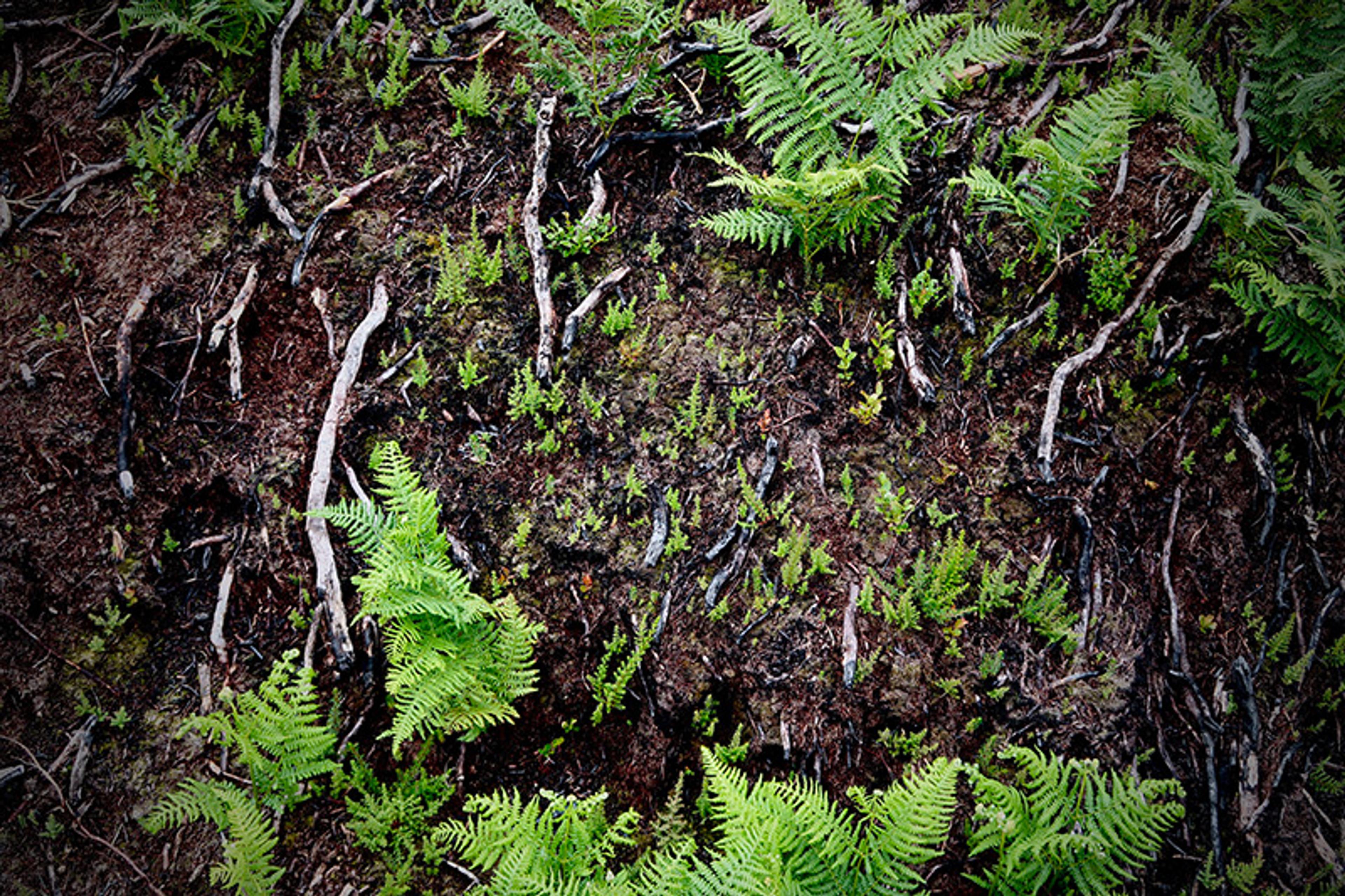
With each season of burning, heather expanded. As its spread accelerated, it became an increasingly valuable resource, inviting new management techniques and new uses. Over time, heather and heather turfs (the soil layer among its roots) were used for thatch on houses, fuel, ‘bedding’ in livestock stalls, building materials, fertiliser and tool-making. The spread of heathlands also allowed pastoralists to expand their livestock and produce more wool, milk and meat.
Some of this history can be seen at Liseborg Høje in Denmark, where archaeologists discovered a small settlement site from the 3rd millennium BCE. In two of the excavated houses, heather stems were found in all the roof-carrying posts. This suggests that heather was being circulated and brought into homes as fuel or bedding. For many of those who lived in northern Europe 5,000-4,000 years ago, heather allowed herds to expand, allowed groups to survive the winter, allowed the construction of temporary settlements and the growth of crops. Heather made life possible.
To make an earth mound, people began using all parts of the heather shrub to create building blocks
In the millennium that followed, the domestication of heather rapidly intensified. By the Early Nordic Bronze Age, around 1700 BCE, peasants and pastoralists had felled even more trees. Sunlit clearings began to puncture the leafy canopies of Early Holocene forests. During this time, Neolithic groups did not settle permanently but travelled wherever they could find the best grazing resources. And they marked their travel routes with mounds of earth called round barrows (or tumuli). A Bronze Age barrow is a dome-shaped mound made from soil or turfs, often 2-5 metres high, and raised over one or several graves. Inside each mound, the dead were buried wearing their clothes, laid to rest alongside weapons, jewellery and other goods.
Situated on highpoints in the landscape, barrows overlooked meadows, heathlands and grasslands. They followed streams and roadways. And they were built along lines, as if marking the pathways that people and livestock moved through in the landscape – some even appear to trace the pathways of ancestors. More than 50,000 of these funerary barrows were erected during only a few centuries in the Early Nordic Bronze Age. But perhaps even more surprising than their distribution is their scale. These burial mounds were monumental. Building one required around 2 to 3 hectares (5-8 acres) of grass or heath. Those 50,000 barrows, led to the devastation of roughly 40,000-60,000 acres of grazing land – roughly equivalent to more than 34,000 soccer pitches.
The building of such barrows required radically different forms of landscape manipulation that went far beyond seasonal burning. To make an earth mound, people began using all parts of the heather shrub to create building blocks. In earlier times, heather was merely grazed or cut, but now its dense root system and surrounding soil (known as ‘turfs’) became equally useful. In archaeological sites across northern Europe, we see broken-down traces of these blocks in the form of small stacks of black-and-white sand – fragments of heather’s transition from an agricultural to an architectural resource. With this novel demand for turfs, humans stripped heathlands of heather and the surfaces they grew in.
Around a millennium later (500 BCE), when the era of highly destructive monumental barrow-building had ceased, Iron Age people used heather and grass turfs in different ways as culture and technologies changed. Life in the Iron Age was more sedentary, requiring permanent structures and the cultivation of a wider range of cereals and crops. Settled forms of agriculture required a steady supply of fertiliser, so people began to build stables, middens, pits and fens to collect livestock dung more effectively. Heather played a role here, too, as fertiliser substrate for agricultural plots where vegetables and grains were grown. Continuing the tradition of turf-cutting, heath turfs were dug up and transported to livestock stalls to soak up faeces and urine. Once loaded with nutrients, turfs were cut and moved to nearby agricultural plots and gardens as fertiliser – a process that continued up to the 19th century as heathlands became integrated into agrarian society. This integration involved the systematic extraction of plant matter, soils and nutrients away from heathlands to intensify crop production elsewhere.
But heather was not a gift given freely.
Centuries of turf-cutting exposed the soil, causing catastrophic sand drift and erosion. Unlike burning and grazing, turf-cutting significantly delayed the time it took heathlands to recover, and made it difficult for other ecologies to evolve. Heather landscapes can recover from burning within 12 to 18 months but recovering from soil-stripping can take 80 to 100 years. Turf-cutting threatened to turn entire landscapes into deserts. This process can be followed at Klegod, a small Iron Age farming settlement on Denmark’s North Sea coast. Here, archaeological fieldwork revealed how multiple waves of sand blew across crops in several successive events, eventually causing the inhabitants to give up and move on. The cost of heathland depletion became too high.
By the dawn of the 20th century, heathlands were exhausted. Centuries of intensive extraction had turned them to sandy, eroded landscapes, depleted of nutrients and species. Soon, the tundra-forged shrubs that once blanketed northern Europe would exist only in patches, relegated to life on the margins once again.
This history is only one side of the story. To tell the other side, we need to look back once again and tell a different tale: this time from the perspective of the heather. This is not a tale of how a domesticated landscape enabled humans to live in particular ways. In fact, shifting our perspective, the history of inland heaths in northern Europe doesn’t even begin with humans. It begins with soil and ice.
Around 24,000 years ago, northern Europe was covered in a thick glacier known as the Weichselian glaciation. This layer of ice, a kilometre-high in some places, extended from Ireland to the eastern edges of Russia, covering Denmark, Iceland, Norway, Sweden and the Baltic. When it started melting in the following millennia, huge plains of sandy, rocky subsoil were exposed, allowing a new biome to spread. The tundra emerged. In this landscape, plants that required low light thrived, and the sandy plains were soon covered in grasses, dwarf shrubs, mosses and lichens. Heather found its place here, too, but it was just one of many flowering shrubs. This moment in deep time, known as the Dryas, is named after one of heather’s botanical kin, Dryas octopetala, with its delicate eight-petal flowers.
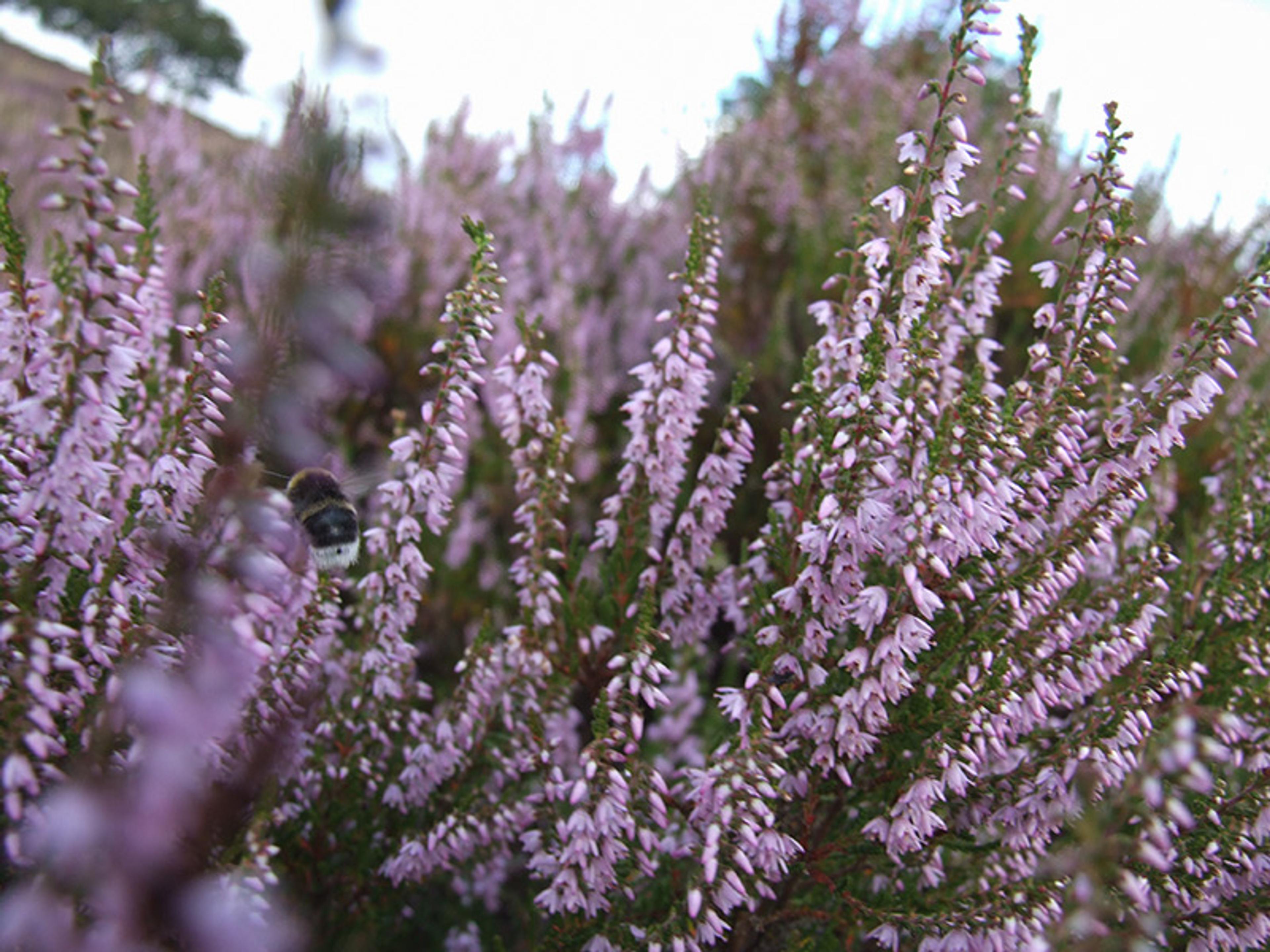
When the ice retreated, heather emerged as a minor figure in a landscape of exceptional patience and slowness. For millennia, shrubs and other tundra plants remained relatively unchanged thanks to cold temperatures, nutrient-poor soils, and grazing mastodon and reindeer. Even the emergence of nomadic groups of hunters in summer months did little to change heather’s ecological status. These groups were not here for shrubs; they came to hunt fox, wolf, hare, wild horses and other tundra animals. The heather waited.
Then came a change. But not for the better. Around 9,500 BCE, the climate warmed as the Pleistocene gave way to a new geological epoch: the Holocene. These changing conditions were more favourable to trees than tundra shrubs, bringing the patience and calm of the post-glacial age to a close. Over millennia, the fallen leaves of these shrubs had formed a layer of extremely fragile millimetre-thin sediments that covered the tundra. Over time, these sediments provided just enough ‘soil’ to give pioneering trees, such as birch and pine, a foothold. An age of forests – and shadows – was dawning. For a few thousand years, surviving patches of heather shared space with scattered hazel, oak, elm and linden trees. As these trees encroached further on the tundra, they formed a dense roof over the remaining shrubs, grasses, mosses and lichens. When the canopy closed, sun-starved heather choked on the shadows of a growing forest.
Heathlands began encouraging forms of survival that were easy for humans to get into but difficult to get out of
Occasionally new heather shoots appeared in the understory or at the edges of wetlands. But the conditions were often not right for heather to spread. The late-glacial tundra landscapes that had fostered it and its kin had disappeared under a dense tangle of trunks, branches and leaves. Again, the heather waited – this time for millennia.
And then, light. The trees began to come down in small clearings across the landscape of the ancient tundra. The oak fell. Ash, birch and linden, too. For the first time in thousands of years, the sun reached down to the understory, feeding the heather’s tiny green leaves as well as those of other plants that had endured from the time of D octopetala. Fire appeared, too. Flames licked the heather’s oil-rich leaves, keeping it young and stimulating its seeds to germinate.
Heather wasn’t the only plant that benefited from these changes: grasses, herbs and other shrubs began to spread, too. But on sandier, nutrient-poor soils, heathlands expanded at an unprecedented scale. Life had returned to the heather, and heathlands marched across the landscape like they did over the late-glacial tundra of the arctic steppe. But, although appearing structurally similar, this newly resuscitated heath was fundamentally different from the one that existed before the forests. The heathlands of the Holocene were anthropogenic. The sunlight and fire were not gifts of a changing climate. They were bestowed by Neolithic agro-pastoralists who began felling and burning the understory to make forest clearings.
But human-resuscitated heather was unstable. It couldn’t be left alone. Heather now depended on the focused attention of people, on frequent grazing by the animals of pastoralists, and on fire to prevent its botanical competitors, such as birch and crowberry, from taking over the new sun-lit clearings. Humans also held back the woods, and their shadows, that always threatened to return. And so, the heather that emerged in the Middle Neolithic needed humans as much as humans needed it. Anthropogenic heathlands began tacitly entrapping their domesticators, encouraging forms of survival that were easy for humans to get into but difficult to get out of. How did a shrubby little tundra plant manage such a feat?
Relationships between humans and plants (as well as plant landscapes) are often explained in terms of domestication, rarely in terms of entrapment. But according to the British archaeologist Ian Hodder, domestication and entrapment are deeply interconnected. Hodder has shown how the domestication of animals locked peasant farmers into patterns of increased labour. In so doing, the capture, penning and protection of animals domesticated peasants, tying them to specific ways of living, working, moving and relating to other animals.
A similar concern with processes of entrapment among European Neolithic people appears in the writings of another archaeologist, John Robb. He has shown how a series of elements and technologies such as cereal cultivation, pottery-making, and domestic and funerary ritualism seem to crop up along particular emergent historical trajectories that are ‘easy to get into but hard to get out of’.
The question of entrapment is not only a question for archaeology. It is also a question of politics. In The Dawn of Everything: A New History of Humanity (2021), the late anthropologist David Graeber and the archaeologist David Wengrow ask ‘How did we get stuck?’ They outline the ways that human life became entangled with domination and ruling elites through charismatic competition as well as control over violence and information. Their book points to the often-unnoticeable long-term processes through which humankind became entrapped in natural and socioecological processes leading to the loss of freedom, flexibility and political creativity.
This helps explain how we become locked into certain relationships with landscapes rather than others – particularly those that may not be easy to escape from. It explains why certain relationships, like those between humans and heather, might be thought of as traps, even though they might initially appear beneficial. Things can look very different after 5,000 (or 50,000) years. Entrapment is not sudden. It takes place in deep time.
To describe the dynamics of this mutual entrapment in deep time, let’s look back once more at our story of humans and heather. Understanding how entrapment functions requires us to understand how the qualities of heather intersected with the desires of early humans – an entanglement that allowed both sides of the relationship to flourish. Heathlands enabled the survival of livestock and the expansion of much larger flock sizes, which in turn made pastoralists deeply dependent on young heath for grazing.
At 20 to 40 years old, a heather plant normally begins to deteriorate and senesce: its outer shoots lie down as the plant dies in the centre. Heather’s ability to regenerate also declines with age, it becomes more susceptible to temperature extremes and pests, and other species become more competitive. And for grazing wildlife and livestock, the nutritional value of heather radically decreases after the first five years. Heather is most nutritious, and therefore most desirable to pastoralists, when it is between one and five years old. All of this is a way of saying that, if pastoralists wanted to continue using this resource, they needed to give it frequent and sustained attention to keep it ‘useful’.
This began to lock people into specific places. If pastoralists wanted to keep using heather for grazing, they had to commit to a specific heathland. They had to keep track of it and know when to start a burn. Humans could not simply use the shrub, travel elsewhere and then expect to return later to an abundant heath. By the time they came back, the landscape would have transformed into forest.
As heather patches grew to monumental sizes, they further restricted other ecological possibilities
Over time, the areal cover of heathlands radically expanded from small forest patches to large-scale steppe-like grazing landscapes, stretching as far as the eye could see. At Lake Solsø in Denmark, a long core drilled out of a lakebed to study historical land-use changes showed that heathlands had already begun to replace forests by 3200 BCE. And evidence of burning can be seen via microscopic pieces of charcoal appearing in soil samples. Fieldwork around Lake Solsø also shows that, by the Early Bronze Age, around 3,700 years ago, the trees were quickly diminishing. The landscape was dominated by heather.
In its entanglement with people and agricultural systems, heathlands have thrived on a logic of expansion. In early agrarian society, without inorganic fertilisers, soil in forest clearings soon became depleted, which was perfect for heather. The forest soon turned to heathlands. And as heather patches grew to monumental sizes, they further restricted other ecological possibilities. The larger the heathland, the longer the distance to the nearest forest (ie, the nearest arboreal seed source), which delayed the time it took for trees to encroach upon the heath. And the larger the fires, the less patchy were the disturbances, which further contributed to the expansion and persistence of heather.
Peasants’ dependency on this resource meant that they had to situate themselves strategically in relation to heathlands. In the Early Iron Age, around 250 BCE, the people of northern Europe settled in substantial enclosed livestock camps close to both heathlands and grasslands, sometimes fortifying such sites with defensive palisades, which they also built further out in the landscape to protect against raiding. When these vast heathlands occupied most available space, farmers would often need to travel more than 12 kilometres to reach the nearest neighbouring farm. And filling all that space? Heather. Those kilometres of heathland were needed so that sheep could graze, as well as to provide ample space to leave fields fallow and allow enough time for soils to regenerate beneath crops and turf-stripped fields.
At its apotheosis, after millennia of expansion, heather blanketed northern Europe. But growth has its limits.
They once seemed indefatigable. But those anthropogenic heathlands that were rescued from beneath the canopies of Holocene forests by Neolithic pastoralists are now threatened with extinction. The heathlands of today are only a fragmented fraction of what used to be.
This loss can be traced to 19th-century landscape reforms in many parts of Europe, which involved strategies of agricultural intensification and privatisation, enclosure, drainage, and the creation of plantations. In the wake of these changes, heathlands became small, isolated pockets in between plantations, croplands, pig farms and windmills. Today, the sprawling heather landscapes of Atlantic northern Europe are almost gone.
This realisation has only heightened in the 2020s as climatic changes – caused, in part, by high levels of atmospheric nitrogen released by industrial livestock production – give more nutrient-demanding plants (such as grasses) a competitive edge over heathlands. To give heather a chance, more intensive methods for heathland reconstruction are now being employed. But attempts to rebuild what was lost come at a high cost to diversity, limiting the possibilities for other species and landscapes.
In some ways, the once-great heathlands of northern Europe are now unsustainable relics. They will most likely disappear within our generation. Their story is one we should take more seriously than ever, because mutual entrapment goes far beyond the ecological ambit of a tundra-forged dwarf shrub.
How will we care for the landscapes that have entrapped us?
The 21st century is filled with hyper-domesticated landscapes and species that have been removed from their original contexts and transformed to fodder, manure, crops and meat. Slaughter animals now outweigh wild mammals by a factor of 15 to one. Chickens now lay more and bigger eggs than their bodies can sustain. The milk production of dairy cows far exceeds that of other cows. Grass and cereals grow disconcertingly fast through nitrogen fertilisers. Many forms of life can now survive only in human-managed growth capsules. We have become entrapped in an unethical, unsustainable and damaging high-fertility production apparatus, with its own logic of expansion. Even the infrastructures that make agricultural production possible involve an ever-expanding formation of consultants, subsidy schemes, education, science, materials and technologies. But domestication never gives free gifts. The costs are high – and inflective. They turn back on us.
In this moment of crisis, what might we learn from the story of heather?
Heathlands are slow and patient, stubborn and unruly. You cannot plant or move a heathland. Its surplus cannot be easily multiplied. The heathland reminds us that there are explicit limits to our dreams of production and growth. And here I’m not just referring to heathlands, but our myriad cultural landscapes, including those maintained by machines. These remind us that the usefulness of our hyper-domesticated landscapes and species is also limited. We arrive at a crossroads: how will we care for the landscapes that have entrapped us? And looking deeper into the future: how will we care for them once they are no longer useful?
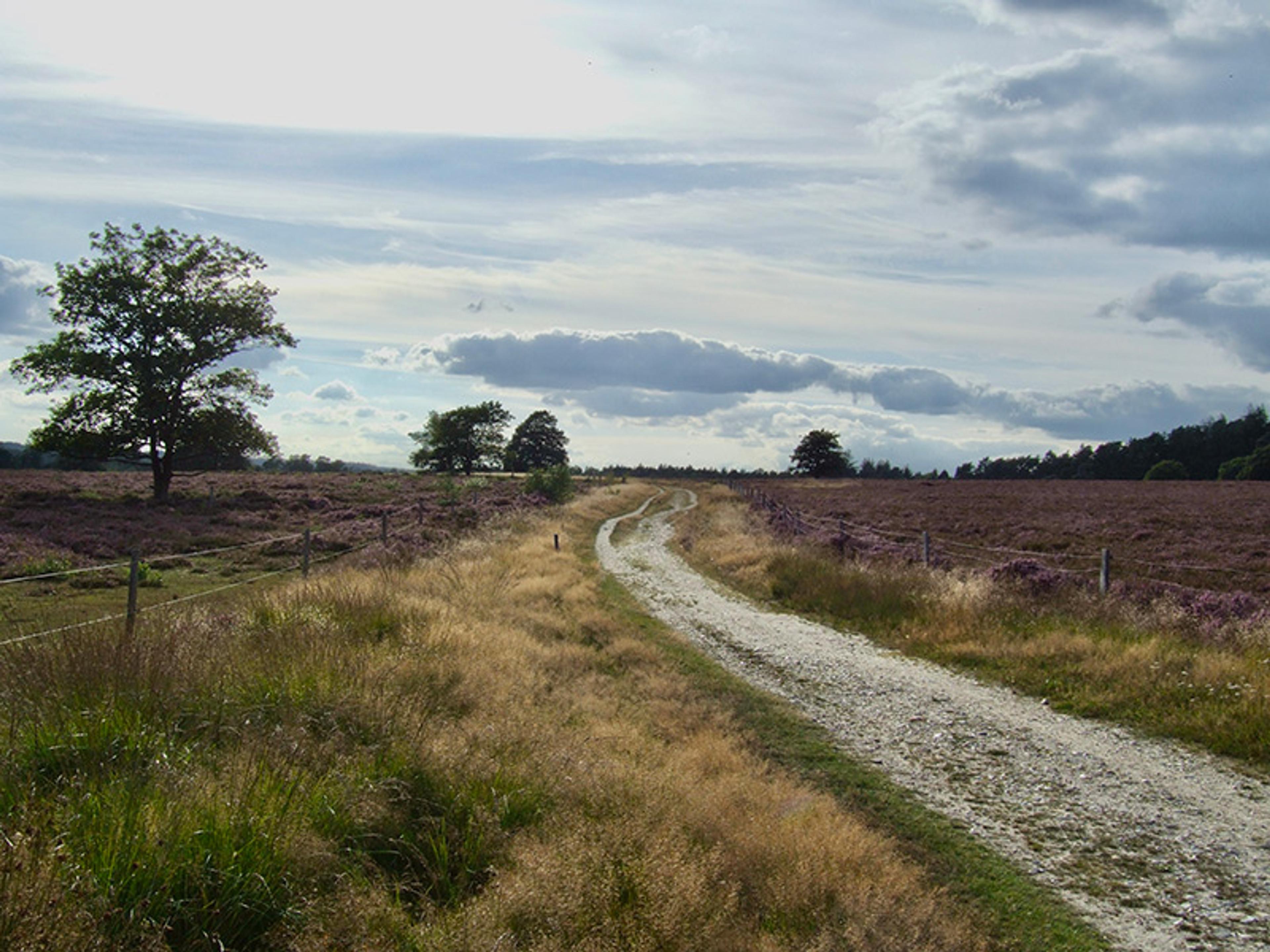
Mutual entrapment is also mutual dependency. The deep-time persistence of heathlands as low-nutrient production landscapes depended on strong relationships with humans, animals, soils and other plants. These relations have not always been characterised by persistent mutual care and commitment. There have been several times when humans have threatened to make heathlands extinct. And being surrounded by heathlands has, at times, made peasants starve and emigrate. However, mutual dependencies were what initially made heathlands such successful cultural landscapes, suggesting that there is something we can learn from heather when thinking about our future landscapes.
It’s a warm afternoon in Odsherred and the heather is blooming. I’m walking across a patchy heath in August 2022, on a peninsula at the northern tip of Zealand in Denmark. In the distance, among purple heather blossoms, I spot a gathering of summerhouse owners carrying garden scissors and other tools. I can hear the low murmur of their voices as they work to remove the sprouting shoots of oak and birch trees that are encroaching on the heath. Small shoots are quickly cut and discarded as the group moves across the landscape, snipping and slicing as they care for small patches of heather.
The heather is not what it used to be. What was once an inshore ocean of C vulgaris, half a century ago, has now shrunk to sporadic pools surrounded by waves of purple moor-grass and wavy hair-grass. The heather has almost disappeared. Its few shoots no longer promise new horizons of entangled possibilities. They’ve become records of a nearly forgotten relationship. As the group works and plays in the landscape, atmospheric nitrogen sinks deeper into the soil, shifting the environment to favour plants that will eventually outcompete the heather. Despite the group’s efforts to remove the encroaching trees, the heath is quietly disappearing again. In the 21st century, heather and humans are no longer locked in cycles of expansion and extraction. To keep heathlands in the world, we now remain locked in cycles of care.
Since the early 20th century, many attempts have been made to save dwindling heathlands like those in Odsherred. At first, experts felt that people were the problem. But contrary to intentions and expectations, when heathlands were suddenly left alone, they soon became forests. Heather once again choked on the shadows of trunks, branches and leaves. The problem, of course, was that its caretakers had misunderstood the nature of the trap: there is no escape.
